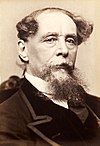
Charles John Huffam Dickens was an English novelist and social critic who created some of the world's best-known fictional characters, and is regarded by many as the greatest novelist of the Victorian era. His works enjoyed unprecedented popularity during his lifetime and, by the 20th century, critics and scholars had recognised him as a literary genius. His novels and short stories are widely read today.
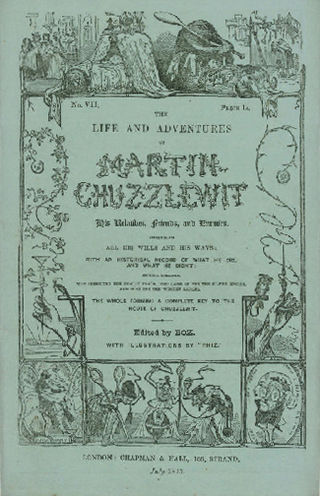
The Life and Adventures of Martin Chuzzlewit is a novel by Charles Dickens, considered the last of his picaresque novels. It was originally serialised between January 1843 and July 1844. While he was writing it Dickens told a friend that he thought it was his best work thus far, but it was one of his least popular novels, judged by sales of the monthly instalments. Characters in this novel gained fame, including Pecksniff and Mrs Gamp.
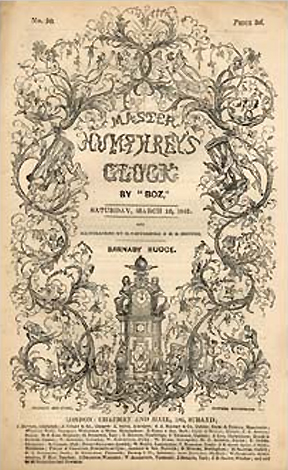
Master Humphrey's Clock was a weekly periodical edited and written entirely by Charles Dickens and published from 4 April 1840 to 4 December 1841. It began with a frame story in which Master Humphrey tells about himself and his small circle of friends, and their penchant for telling stories. Several short stories were included, followed by the novels The Old Curiosity Shop and Barnaby Rudge. It is generally thought that Dickens originally intended The Old Curiosity Shop as a short story like the others that had appeared in Master Humphrey's Clock, but after a few chapters decided to extend it into a novel. Master Humphrey appears as the first-person narrator in the first three chapters of The Old Curiosity Shop but then disappears, stating, "And now that I have carried this history so far in my own character and introduced these personages to the reader, I shall for the convenience of the narrative detach myself from its further course, and leave those who have prominent and necessary parts in it to speak and act for themselves."

Sampson Brass is a fictional character in the 1841 novel The Old Curiosity Shop by Charles Dickens. He is a corrupt attorney who affects feeling for his clients, whom he then cheats. Among his clients is the villainous Daniel Quilp, the novel's antagonist. From Bevis Marks in the city of London, he assists Quilp in fraudulently gaining possession of Nell's grandfather's house, plots against Kit Nubbles, and hires and then dismisses Dick Swiveller.
Master Humphrey is the narrator and main character in Dickens's serial, Master Humphrey's Clock. He is also the unnamed narrator of the first three chapters of Dickens's 1841 novel The Old Curiosity Shop, which was originally published in that serial. It is revealed in the portion of Master Humphrey's Clock which follows The Old Curiosity Shop that he is also in fact the unnamed 'single gentleman' who appears in the second half of that novel.
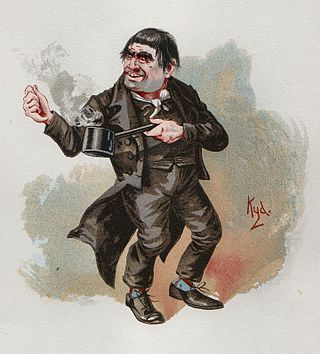
Daniel Quilp is one of the main antagonists in the novel The Old Curiosity Shop by Charles Dickens, written in 1840. Quilp is a vicious, ill-tempered and grotesque dwarf and is the villain of the story. Quilp is as near as Dickens ever came to creating a monster. Actors who have portrayed him include Hay Petrie, Anthony Newley, Patrick Troughton, Trevor Peacock, and Toby Jones.
The bibliography of Charles Dickens (1812–1870) includes more than a dozen major novels, many short stories, several plays, several non-fiction books, and individual essays and articles. Dickens's novels were serialized initially in weekly or monthly magazines, then reprinted in standard book formats.

The Old Curiosity Shop is a British television film adapted from the Charles Dickens's 1841 novel The Old Curiosity Shop. It stars Irish actress Sophie Vavasseur as Nell Trent, with Derek Jacobi as her grandfather, Toby Jones as Quilp and George MacKay as Nell's friend, Kit. It was broadcast on 26 December 2007 on ITV. The adaptation is in general very faithful to the novel. The most significant changes are the removal of the Garlands and their household and the identity of the Single Gentleman who is changed from Grandfather's brother to his estranged son and Nell's father.
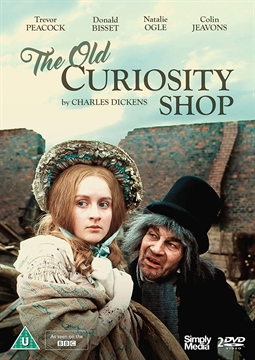
The Old Curiosity Shop is a nine part 1979 BBC TV series based on the 1841 novel by Charles Dickens. It was directed by Julian Amyes, and adapted by William Trevor.
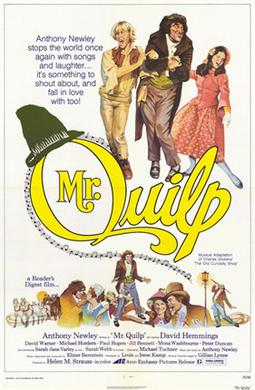
Mister Quilp is a 1975 British musical film directed by Michael Tuchner and starring Anthony Newley, David Hemmings and Jill Bennett. It is based on the 1841 novel The Old Curiosity Shop by Charles Dickens.

The Old Curiosity Shop is a 1934 British drama film directed by Thomas Bentley and starring Elaine Benson, Ben Webster and Hay Petrie. It is an adaptation of Charles Dickens' 1841 novel The Old Curiosity Shop.

Joseph Clayton Clark, who worked under the pseudonym "Kyd", was a British artist best known for his illustrations of characters from the novels of Charles Dickens. The artwork was published in magazines or sold as watercolor paintings, rather than included in an edition of the novels.
The Old Curiosity Shop is a 1921 British silent drama film directed by Thomas Bentley and starring Mabel Poulton, William Lugg and Hugh E. Wright. It is based on the 1841 novel The Old Curiosity Shop by Charles Dickens. Bentley remade the novel as a sound film in 1934.
The Old Curiosity Shop is a 1914 British silent drama film directed by Thomas Bentley and starring Mai Deacon, Warwick Buckland and Alma Taylor. It was based on the 1841 novel The Old Curiosity Shop by Charles Dickens, and was the first of three film adaptations of the story by Bentley. It was made by the Hepworth Company, the leading British film studio before the First World War.
The Old Curiosity Shop is a 1984 Australian animated film based on the 1841 novel by Charles Dickens about a young girl (Nell) who lives with her grandfather in a shop, and what happens after they are evicted from the shop by Quilp, a moneylender. It was made by Burbank Films who produced a number of animated films based on classic novels. Their slate cost an estimated $11 million. The Dickens films sold to 20th Century Fox in the US and to the Seven Network in Australia.
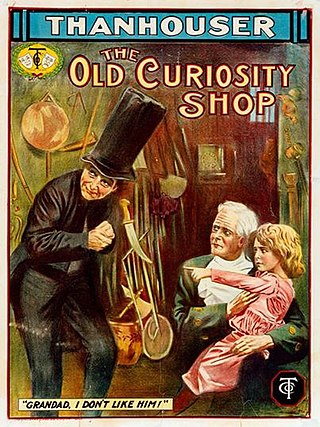
The Old Curiosity Shop is a 1911 American silent short drama film produced by the Thanhouser Company. The film is an adaptation of the 1841 novel The Old Curiosity Shop by Charles Dickens that was limited to the time constrictions of the single reel format. The film focuses on the grandfather who gambles into poverty and the consequences which eventually claim the life of Little Nell. Its survival and attribution as a Thanhouser film was noted by Kamilla Elliott in her 2003 book Rethinking the Novel/Film Debate under the title Little Nell. In 2012, the work was confirmed to be a Thanhouser production at the Pordenone Silent Film Festival. The identification of the film as Little Nell arose due to head of the film having been lost.

Mary Scott Hogarth was the sister of Catherine Dickens and the sister-in-law of Charles Dickens. Hogarth first met Charles Dickens at age 14, and after Dickens married Hogarth's sister Catherine, Mary lived with the couple for a year. Hogarth died suddenly in 1837, which caused Dickens to miss the publication dates for two novels: The Pickwick Papers and Oliver Twist. Hogarth later became the inspiration for a number of characters in Dickens novels, including Rose Maylie in Oliver Twist and Little Nell in The Old Curiosity Shop. Charles and Catherine Dickens' first daughter was named Mary in her memory.

Nell Trent, also referred to as Little Nell, is a fictional character in the 1841 novel The Old Curiosity Shop by Charles Dickens. The novel's main character, she is portrayed as infallibly good and virginal. An orphan, she leads her grandfather on their journey to save them from misery but gradually becomes weaker throughout the journey, and although she finds a home with the help of a schoolmaster, she sickens and dies before her friends in London find her. Her death has been described as "the apotheosis of Victorian sentimentality."

Richard "Dick" Swiveller is a fictional character in the 1841 novel The Old Curiosity Shop by Charles Dickens. Initially a comical accessory to the antagonists in the novel, he undergoes a transformation, becoming a key helpmate bridging the depiction of the main characters that are either mostly villainous or goodly in nature.




















